USA's Radio-Orienteers Compete in Asia
Three Reports

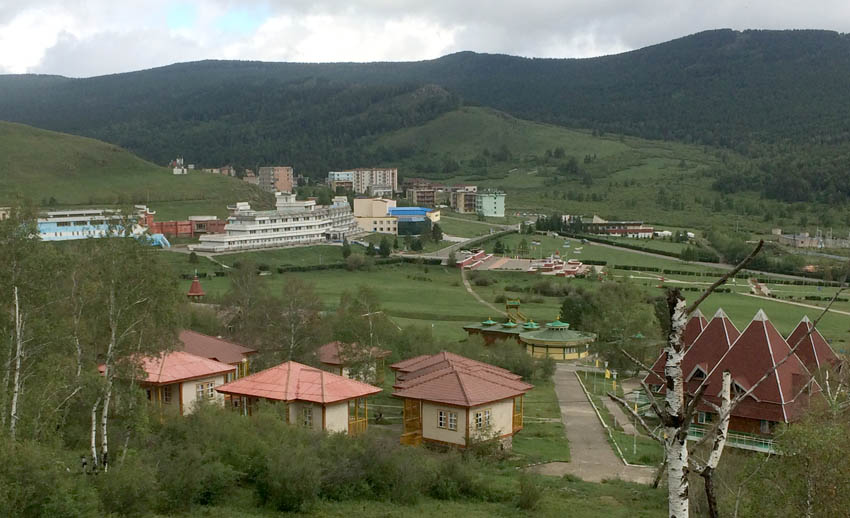
The Nairamdal International Children's Center, headquarters for the 2017 IARU Region 3 ARDF Championships. (Photos in this report by Dale and Kuon Hunt)
The 2017 IARU Region 3 ARDF Championships
A First-Person Report by Kuon Hunt KB7WRG and Dale Hunt WB6BYU
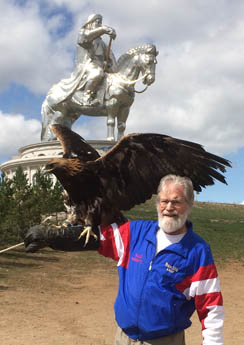
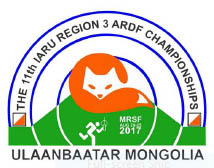 What a fascinating experience the 2017 Region 3 Championships were! Dale and I were the only participants coming from Region 2, participating as members of Region 3, based on the USA's territories spread across the Pacific. The other non-Mongolian Region 3 teams participating, in order of size, were China, Japan, Korea, Australia and Macao (as observers only). Kazakhstan participated as visitors from Region 1. There were about 180 competitors and team officials. The Mongolians put on a great show and most of their logistics were superb. What the organizers in this very dry country -- home to the Gobi Desert -- hadn't counted on was rain. Although late summer is the rainy season there, the volume and location of the rain played very much into our experience of the 2m competition, especially.
What a fascinating experience the 2017 Region 3 Championships were! Dale and I were the only participants coming from Region 2, participating as members of Region 3, based on the USA's territories spread across the Pacific. The other non-Mongolian Region 3 teams participating, in order of size, were China, Japan, Korea, Australia and Macao (as observers only). Kazakhstan participated as visitors from Region 1. There were about 180 competitors and team officials. The Mongolians put on a great show and most of their logistics were superb. What the organizers in this very dry country -- home to the Gobi Desert -- hadn't counted on was rain. Although late summer is the rainy season there, the volume and location of the rain played very much into our experience of the 2m competition, especially.
(Dale's comments in italics.) Most of Mongolia that isn't desert is stepp: short grass (green in summer, unlike California and other parts of the US) with few bushes, and no trees to speak of, except perhaps along a river. Finding forested courses for ARDF takes some work -- they tend to be at higher elevations along steep ridges.
Another thing that Mongolia needed in order to host a Championship was modern transmitters. The Japanese agreed to provide transmitters (though it took a while to get them through Customs) and the Koreans provided SportIdent sticks, operators, and software. This was an excellent example of inter-region cooperation.
The rainy 2m competition day started with breakfast at 5:30 am in the "canteen" of Nairamdhal, the International Children's Center, where we all were housed in dormitory rooms with four twin beds each. We shared a room with Ewen and Jenelle Templeton from Australia, with the rest of the Aussies next door to make it easier for the translator. Nairamdhal is a large facility, the largest of its kind in the country, and its location in a steep valley outside Ulaan Bataar was lovely and a bit isolated. On this day the buses left -- with a police escort -- at 6:30 am for another camp, a ger (yurt) camp, at some distance from us. It was necessary for the buses to circumnavigate a small cluster of steep mountains to get to the camp, which was on the other side of the mountains.
We arrived two and a half hours later to discover that our 9:00 am start times had been delayed by three hours due, we assumed, to "technical difficulties." Our ride into the camp had been adventurous. Interlaced, rutted dirt roads over rolling grassland were the only access to the camp, once one left the little nearby town behind. Different of our buses chose different roads, depending on the individual driver's assessment of each road's slipperiness co-efficient and apparent navigability. "Interesting, but not too bad," we decided, as we debarked enthusiastically for the mile-long walk to the covered staging area.
Looking at the locations on Google Maps, the driving distance was 56 km and the expected driving time is 1-1/2 hours. But that didn't include the dirt roads (including a detour around a railroad underpass that was too low for the buses) or the morning rush hour traffic.
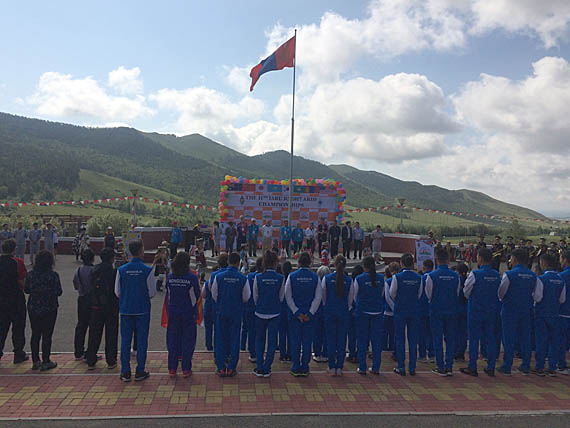
Officials on stage at the opening ceremonies.
Once the competition began about noon, things were well organized and the course, in the intermittent rain, was challenging. Some of the terrain was relatively steep, but the course was appropriate and well set. Dale did well for his level of physical preparedness (given that he walked the whole course) and decided to make a sprint down the finish corridor. He was not prepared for the rock hidden in the mud just before the finish punch, however, and he did a full face-plant over the finish line after breaking his toe on the rock. Then, ever aware of his true purpose, he reached up from the ground and inserted his SportIdent into the punch.
Kuon's finish was much less spectacular. In her effort to carefully avoid what she interpreted as strong reflections, she went the wrong way to the finish, ending up nearly a mile away before she realized her mistake and headed toward the finish, only to time out.
The map was announced as 1:25,000 on A4 paper (close to 8 1/2 x 11) with five-meter contour lines. We decided from that it must be relatively gentle terrain, or the contours would be too close together. Based on the elevations marked on the map, the contours really were ten meters, and, yes, it was steep. Coloring was more like a USGS topo map: dark green for "forest" and white for "not forest." The south side of the valley was forested, the north side was mostly open land.
From the start there was a particularly steep ridge to the left that caused a lot of reflections, with the finish and most of the controls around to the right. Start elevation was 1560 meters, and the map went up to 1900 meters in several spots, and nearly 2000 meters in the far right corner, though the course didn't use all the available elevation. (But it was high enough for a good workout.)
Lunch and a rest were provided in the lodge near the finish. Then it was time for the mile or so walk back to the buses except for Dale, who got a ride. The bus ride back to Nairamdhal was a little more exciting, however. The day's rain had made the maze of dirt roads even more slippery. Our driver stopped often to survey the landscape, sometimes deciding to follow other buses and sometimes deciding to launch off on another track. Slip-and-slide on rutted roads in a full sized bus, far from town and as dark is falling, is an interesting game to play. The trip back took a number of hours, which included at least three stops where drivers deserted their buses to go dig out another bus. Fortunately, we were never the bus being liberated from the mire, nor was anyone ever hurt in the process. We gave our driver an ovation when we reached the paved road.
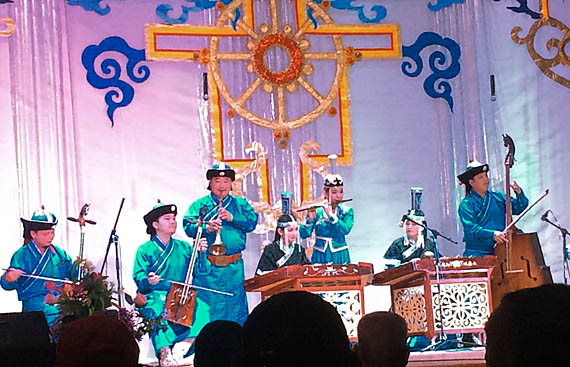
Entertainment during the opening ceremonies.
We returned to dinner at Nairamdhal at 9:00 pm, after which the scheduled awards ceremony and round of meetings were not held. Everyone went to sleep, except Dale. At 11:30 pm he was rousted to head to the hospital in Ulaan Bataar, the event doctor having decided that his foot required further investigation. An injured Korean competitor and he were loaded in a car with two translators and assorted staff. He was back about 2:30 am, X-rays in hand, having been told he needed surgery to place a pin in the toe, surgery he needed to have done back in the USA.
Blessedly, the next day was a "culture day," where most folks went out for tours, shopping and Mongolian BBQ. We stayed back in our dorm room, so Dale could rest and assess his toe. He decided it really did seem that the doctor was right, and -- as long as he didn't allow it to bend -- it was mostly serviceable. We would not have to leave immediately. We heard from our Aussie roommates that the "culture day" was a raging success. It was followed that evening by concerts and the postponed awards ceremony, a very well-staged affair, in which all the officials and team leaders, including Dale on his crutch, awarded medals to deserving competitors.
We had both decided to skip the 80m competition the next day (again advertised as breakfast at 5:30 am and buses at 6:30 am), Dale for obvious reasons (and not having any shoes that he could get his to into if it was muddy) and Kuon in order to keep Dale company for the potential fifteen hours we might have been gone. This decision to stick by her man was a poor one on Kuon's part, however, as the buses never materialized, and the competition turned out to be held in the valley in which Nairamdhal sat. The good news was that they could both watch the finish and applaud the competitors. The later awards ceremony and banquet were very lovely affairs, with plenty of alcohol and food and well wishes to be had at the banquet.
The competitors walked around the hill northeast from Nairamdhal to the start. The map covered part of that valley, and the steep ridge between there and the the finish corridor on the far side of the Childrens Center. It was all grassy on our side of the ridge, and we could see competitors arriving from multiple directions. At least three more competitors were hobbling at the awards ceremony that night.
One of the wonderful things to see and learn about for us were all the young competitors from the countries present. Most have ARDF electives available in their schools on a regular basis. With this kind of training, they are very skillful and very fit, even in their early teens. What a difference from USA's youth! Another was the country and people of Mongolia. It is a beautiful and wide open place with charming, friendly people. Violence against women and street crime are rarities there, making it a safe and pleasant place to visit.
We were happy to see that no country ran away with the awards, which were well distributed. Anecdotally, Japan appeared to do best in M60 and Mongolia in W60, which were the two categories of most interest to us. The guts and glory of the kids, though, bounding down the steep hillsides with enthusiasm and grace, were amazing to behold! Would that the USA had equally trained and interested children to compete with them.
Kuon Hunt KB7WRG
4 September 2017
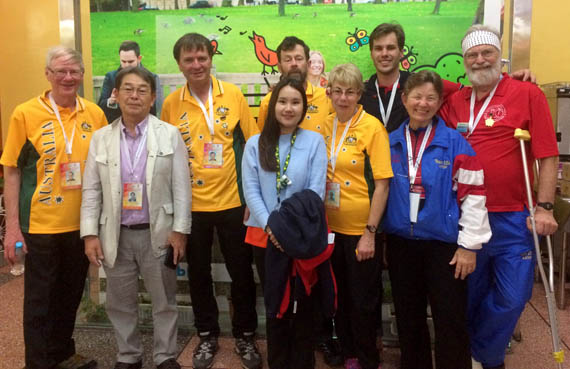
Australian and USA team members. Kuon and Dale Hunt are at right. Lady in blue top at center is translator and support person for English-speaking guests.


Displaying their medals in China are ARDF Team USA members Ruth Bromer WB4QZG, Joseph Huberman K5JGH and Vadim Afonkin KB1RLI. (Photo courtesy KB1RLI)
USA Participates in China International ARDF Championships
Guangzhou, China, December 3 - 9, 2015
 Over four dozen middle- and high-school youth plus some of their teachers, coaches and parents came to the USA in August 2015 to participate in the USA and IARU Region 2 ARDF championships. They were from Guangzhou No. 2 High School in China, where ARDF is a popular extracurricular sport.
Over four dozen middle- and high-school youth plus some of their teachers, coaches and parents came to the USA in August 2015 to participate in the USA and IARU Region 2 ARDF championships. They were from Guangzhou No. 2 High School in China, where ARDF is a popular extracurricular sport.
The Guangzhou school group had such a good time in the USA that they reciprocated later in the year. Stateside radio-orienteers were invited to visit their country for the 2015 China International ARDF Championships, which took place in the city of Guangzhou in Guangdong Province of south China from December 3 through 9. These championships were organized by the Guangdong ARDF Radiosports Club (GARC).
Events included one day of unofficial training, followed on successive days by 80-meter classic, sprint, two-meter classic and foxoring competitions. There were also afternoon and evening cultural events including a Pearl River night cruise. Awards were presented in all eleven IARU championship age/gender categories, plus M13, M16, W13 and W16.
December might seem like a cold month for ARDF in the northern hemisphere, but Guangzhou, also known as "Flower City," is considered to be "the Hawaii of China" with average December high temperatures of 69.1 degrees Fahrenheit and average lows of 62.7. Its pleasant subtropical climate in the Pearl River Delta may explain why Guangzhou has become the third largest city in China.
Here are some photos of USA's participation. More information is on the English-language (mostly) GARC event Web page.

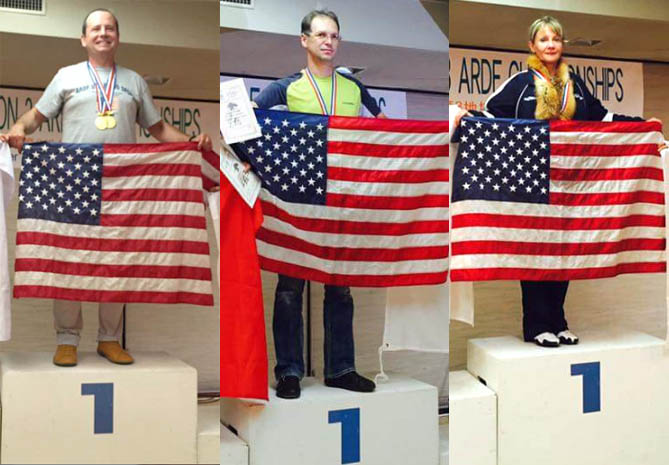
The three members of ARDF Team USA in Japan: Nicolai Mejevoi, Vadim Afonkin KB1RLI and Alla Mezhevaya. Each stood on this gold medal platform at least twice. (Photos courtesy KB1RLI)
Team USA Earns Ten Medals at IARU Region 3 ARDF Championships
Gunma, Japan, September 6 - 11, 2015
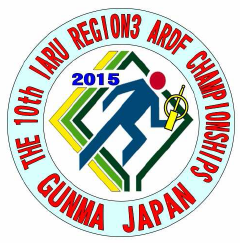 Region three of the International Amateur Radio Union encompasses much of Asia and Oceania. USA has territories within Region 3 (Guam, for instance). Because of this, ARRL is a member society of IARU Region 3 and USA is entitled to enter a team of competitors in Region 3 ARDF events. So it was that three radio-orienteers from USA traveled to Gunma, Japan for the 2015 IARU Region 3 ARDF Championships. Competing against over one hundred ARDF experts from Australia, China, Chinese Taipei, Japan and Kazakhstan, each of the three brought home medals.
Region three of the International Amateur Radio Union encompasses much of Asia and Oceania. USA has territories within Region 3 (Guam, for instance). Because of this, ARRL is a member society of IARU Region 3 and USA is entitled to enter a team of competitors in Region 3 ARDF events. So it was that three radio-orienteers from USA traveled to Gunma, Japan for the 2015 IARU Region 3 ARDF Championships. Competing against over one hundred ARDF experts from Australia, China, Chinese Taipei, Japan and Kazakhstan, each of the three brought home medals.
In the first classic race on September 8, USA's Alla Mezhevaya was the only competitor in her category to find all required transmitters. Vadim Afonkin KB1RLI won gold by finding all of his transmitters in just 0:46:54, which was 21 minutes faster than the silver medalist. Next day, Alla and Vadim captured gold again in the sprint. In the second classic race on September 10, Nicolai Mejevoi tied for first place with Inwon Lee of China. Each found all required transmitters in exactly 0:44:22 to receive gold. Alla won gold and Vadim won silver. In foxoring on the final competition day, Alla's time for all required transmitters was an hour and 27 minutes better than second place. Vadim and Nicolai also won gold in their categories.
TEAM USA MEDALS
Alla Mezhevaya W35
Classic 1 gold
Sprint gold
Classic 2 gold
Foxoring gold
Vadim Afonkin KB1RLI M40
Classic 1 gold
Sprint gold
Classic 2 silver
Foxoring gold
Nicolai Mejevoi M50
Classic 2 gold (tie)
Foxoring gold
Congratulations ARDF Team USA!
Joe Moell KØOV
 Back to Latest Championship Foxhunting News -- Stories of recent ARDF events and announcements of upcoming ones
Back to Latest Championship Foxhunting News -- Stories of recent ARDF events and announcements of upcoming ones
Go to International-Style Foxhunting Comes To The Americas -- How we're getting the ball rolling
Go to Equipment Ideas for Radio-Orienteering -- Simple and inexpensive receiving and transmitting solutions
Go to Radio Foxhunting in southern California -- Announcements of upcoming demonstration/practice sessions and results of recent local events
Back to the Homing In home page
This page updated 15 January 2021
![]()


 What a fascinating experience the 2017 Region 3 Championships were! Dale and I were the only participants coming from Region 2, participating as members of Region 3, based on the USA's territories spread across the Pacific. The other non-Mongolian Region 3 teams participating, in order of size, were China, Japan, Korea, Australia and Macao (as observers only). Kazakhstan participated as visitors from Region 1. There were about 180 competitors and team officials. The Mongolians put on a great show and most of their logistics were superb. What the organizers in this very dry country -- home to the Gobi Desert -- hadn't counted on was rain. Although late summer is the rainy season there, the volume and location of the rain played very much into our experience of the 2m competition, especially.
What a fascinating experience the 2017 Region 3 Championships were! Dale and I were the only participants coming from Region 2, participating as members of Region 3, based on the USA's territories spread across the Pacific. The other non-Mongolian Region 3 teams participating, in order of size, were China, Japan, Korea, Australia and Macao (as observers only). Kazakhstan participated as visitors from Region 1. There were about 180 competitors and team officials. The Mongolians put on a great show and most of their logistics were superb. What the organizers in this very dry country -- home to the Gobi Desert -- hadn't counted on was rain. Although late summer is the rainy season there, the volume and location of the rain played very much into our experience of the 2m competition, especially.




 Over four dozen middle- and high-school youth plus some of their teachers, coaches and parents came to the USA in August 2015 to participate in the
Over four dozen middle- and high-school youth plus some of their teachers, coaches and parents came to the USA in August 2015 to participate in the 
 Region three of the International Amateur Radio Union encompasses much of Asia and Oceania. USA has territories within Region 3 (Guam, for instance). Because of this, ARRL is a member society of IARU Region 3 and USA is entitled to enter a team of competitors in Region 3 ARDF events. So it was that three radio-orienteers from USA traveled to Gunma, Japan for the 2015 IARU Region 3 ARDF Championships. Competing against over one hundred ARDF experts from Australia, China, Chinese Taipei, Japan and Kazakhstan, each of the three brought home medals.
Region three of the International Amateur Radio Union encompasses much of Asia and Oceania. USA has territories within Region 3 (Guam, for instance). Because of this, ARRL is a member society of IARU Region 3 and USA is entitled to enter a team of competitors in Region 3 ARDF events. So it was that three radio-orienteers from USA traveled to Gunma, Japan for the 2015 IARU Region 3 ARDF Championships. Competing against over one hundred ARDF experts from Australia, China, Chinese Taipei, Japan and Kazakhstan, each of the three brought home medals.
